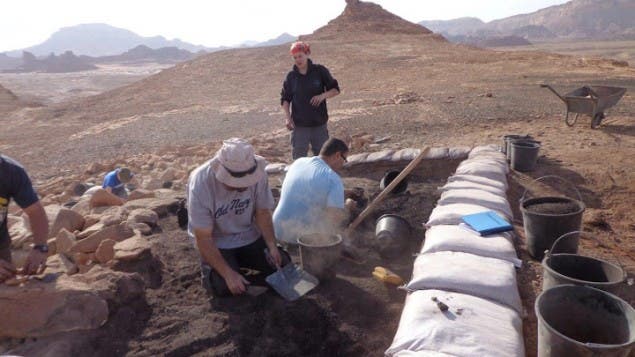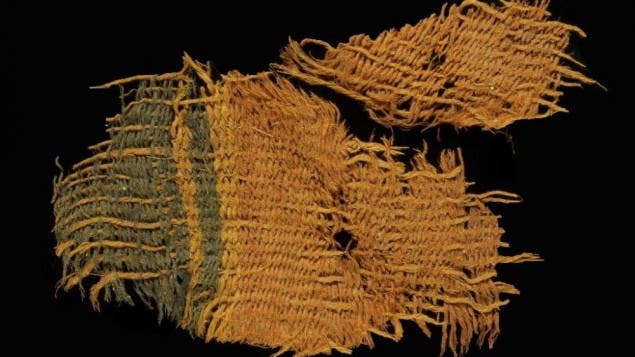Recent archaeological findings in the Timna region in Israel’s southern Arava Valley showcase the surprising variety and quality of the clothes worn some 3,000 years ago.
If there’s anything my girlfriend has thought me is that I don’t know anything about modern fashion. And she’s right, I’m the Jon Snow of haute couture. But since fashion is something that she can get really caught up in, I thought I’d start from the beginning and learn my way from there — and you can’t really get any earlier that ancient Israel.

Image credits Central Timna Valley Project/TAU.
So, what would have been on the catwalk in the days of King Solomon? Recent archaeological findings by a team from Tel Aviv University might answer that question. They uncovered an extensive collections of fabrics in the country’s southern desert copper mines. This is the first discovery of the materials people wore some 3,000 years ago, Israel’s Foreign Ministry reports.
“No textiles have ever been found at excavation sites like Jerusalem, Megiddo and Hazor, so this provides a unique window into an entire aspect of life from which we’ve never had physical evidence before,” said lead archaeologist Erez Ben-Yosef in a statement Wednesday.
“We found fragments of textiles that originated from bags, clothing, tents, ropes and cords.”
Try to imagine an ancient Israeli getup, I’ll wait. Done? The first images to pop in your head are the ones from movies like Passion of the Christ, right? Where everyone is wearing a gray sack with a hole cut out for their head, looking miserable. And even the fancier clothes look like they’re weaved from something so rough it makes your eyes itchy.
And well, probably. But the rich, powerful and influential people of the time had a pretty impressive range of clothing to choose from. Varied materials, colors and models were available to them, the findings show.

Image credits Clara Amit/Israel Antiquities Authority.
The fabrics were found in Timna in the Arava Valley of southern Israel, an active mining area around the 10th century BC, during King Solomon’s reign. The colorful artifacts offer unique insight into the attires, but also the trade practices and economy of that period.
Many of the fabrics, including water-intensive linen cloths, were grown and woven far from the mine in which they were found. This hints at intense trade between the Timna region and Northern Israel of the Jordan Valley, with copper exports being used to pay for the daily goods that were required by the community to survive in Israel’s harsh deserts.
“We found linen, which was not produced locally,” said TAU masters student Vanessa Workman.
“It was most likely from the Jordan Valley or northern Israel. The majority of the fabrics were made of sheep’s wool, a cloth that is seldom found in this ancient period.”
Far from the undyed fabrics we’re used to associate with those times, archaeologists found fragments of a surprising variation in color, weaving patterns and ornamentation. One woolen fragment, for example, is dyed red and blue with strands of animal hair woven in to form decorative bands within the fabric.
“We found simply woven, elaborately decorated fabrics worn by the upper echelon of their stratified society,” Ben-Yosef adds.
“Luxury- grade fabric adorned the highly skilled, highly respected craftsmen managing the copper furnaces. They were responsible for smelting the copper, which was a very complicated process.”

Image credits Clara Amit/Israel Antiquities Authority.
Turns out Hollywood isn’t the best source for accurate historical info (who would have guessed, right?). These fabrics adorned the higher-ups in the society, men with the skill to turn ore into precious copper. The mines themselves were worked by slaves, in harsh conditions and presumably, humbler attires.
“Miners in ancient Timna may have been slaves or prisoners; theirs was a simple task performed under difficult conditions,” Ben-Yosef concludes.
“But the act of smelting, of turning stone into metal, required an enormous amount of skill and organization. The smelter had to manage some 30 to 40 variables in order to produce the coveted copper ingots.”
The findings show the geopolitical and economical importance of the Edomites (the tribe living in this region and working the copper mines) during the time of King Solomon. Supplying a population with water, food and other goods in the middle of the desert raises difficulties even today, and must have been a Sisyphean task with the age’s technological levels.
“Copper was a source of great power, much as oil is today,” Ben-Yosef concludes.
“If a person had the exceptional knowledge to create copper, he was considered well-versed in an extremely sophisticated technology.”
The fabrics are just one part of the larger Central Timna Valley Project, an ongoing effort started in 2012 to explore the archaeological record of the southern Arava’s copper mining and smelting sites. Arid conditions in the area have helped organic materials such as fabric and leather survive.






